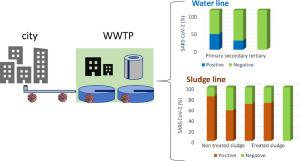Water Research ( IF 11.4 ) Pub Date : 2021-07-15 , DOI: 10.1016/j.watres.2021.117435 Albert Serra-Compte 1 , Susana González 1 , Marina Arnaldos 1 , Sabrina Berlendis 2 , Sophie Courtois 2 , Jean Francois Loret 2 , Olivier Schlosser 2 , Adela M Yáñez 3 , Elena Soria-Soria 3 , Mariana Fittipaldi 3 , Gemma Saucedo 4 , Anna Pinar-Méndez 4 , Miquel Paraira 4 , Belén Galofré 4 , Juan M Lema 5 , Sabela Balboa 5 , Miguel Mauricio-Iglesias 5 , Albert Bosch 6 , Rosa M Pintó 6 , Isabelle Bertrand 7 , Christophe Gantzer 7 , Carlos Montero 1 , Xavier Litrico 8

|
The Severe Acute Respiratory Syndrome Coronavirus 2 (SARS-CoV-2) is shed in the feces of infected people. As a consequence, genomic RNA of the virus can be detected in wastewater. Although the presence of viral RNA does not inform on the infectivity of the virus, this presence of genetic material raised the question of the effectiveness of treatment processes in reducing the virus in wastewater and sludge. In this work, treatment lines of 16 wastewater treatment plants were monitored to evaluate the removal of SARS-CoV-2 RNA in raw, processed waters and sludge, from March to May 2020. Viral RNA copies were enumerated using reverse transcriptase quantitative polymerase chain reaction (RT-qPCR) in 5 different laboratories. These laboratories participated in proficiency testing scheme and their results demonstrated the reliability and comparability of the results obtained for each one. SARS-CoV-2 RNA was found in 50.5% of the 101 influent wastewater samples characterized. Positive results were detected more frequently in those regions with a COVID-19 incidence higher than 100 cases per 100,000 inhabitants. Wastewater treatment plants (WWTPs) significantly reduced the occurrence of virus RNA along the water treatment lines. Secondary treatment effluents showed an occurrence of SARS-CoV-2 RNA in 23.3% of the samples and no positive results were found after MBR and chlorination. Non-treated sludge (from primary and secondary treatments) presented a higher occurrence of SARS-CoV-2 RNA than the corresponding water samples, demonstrating the affinity of virus particles for solids. Furthermore, SARS-CoV-2 RNA was detected in treated sludge after thickening and anaerobic digestion, whereas viral RNA was completely eliminated from sludge only when thermal hydrolysis was applied. Finally, co-analysis of SARS-CoV-2 and F-specific RNA bacteriophages was done in the same water and sludge samples in order to investigate the potential use of these bacteriophages as indicators of SARS-CoV-2 fate and reduction along the wastewater treatment.
中文翻译:

废水和污泥处理过程中消除 SARS-CoV-2
严重急性呼吸系统综合症冠状病毒 2 (SARS-CoV-2) 通过感染者的粪便排出。因此,可以在废水中检测到病毒的基因组 RNA。尽管病毒RNA的存在并不能说明病毒的传染性,但遗传物质的存在提出了处理过程在减少废水和污泥中病毒的有效性方面的问题。在这项工作中,从 2020 年 3 月到 5 月,对 16 个废水处理厂的处理线进行了监测,以评估原水、处理水和污泥中 SARS-CoV-2 RNA 的去除情况。使用逆转录酶定量聚合酶链反应计数病毒 RNA 拷贝(RT-qPCR) 在 5 个不同的实验室进行。这些实验室参与了能力验证计划,其结果证明了每个实验室获得的结果的可靠性和可比性。在 101 个进水废水样本中,50.5% 发现了 SARS-CoV-2 RNA。在每 10 万居民中 COVID-19 发病率高于 100 例的地区,检测到阳性结果的频率更高。废水处理厂 (WWTP) 显着减少了水处理线路沿线病毒 RNA 的出现。二级处理出水显示,23.3%的样品中存在SARS-CoV-2 RNA,经过MBR和氯化后未发现阳性结果。未经处理的污泥(来自初级和二级处理)的 SARS-CoV-2 RNA 出现率高于相应的水样,这证明了病毒颗粒对固体的亲和力。此外,经过浓缩和厌氧消化后,在处理过的污泥中检测到了SARS-CoV-2 RNA,而只有在进行热水解时,病毒RNA才从污泥中完全消除。 最后,在相同的水和污泥样品中对 SARS-CoV-2 和 F 特异性 RNA 噬菌体进行了共同分析,以研究这些噬菌体作为 SARS-CoV-2 命运和废水排放减少指标的潜在用途治疗。











































 京公网安备 11010802027423号
京公网安备 11010802027423号